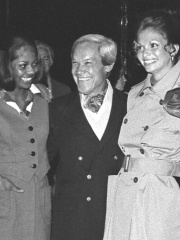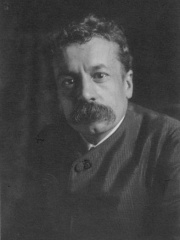
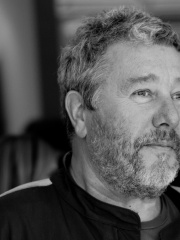
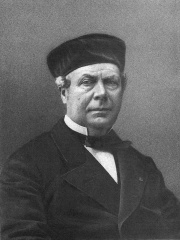
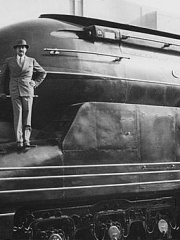
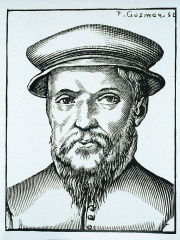
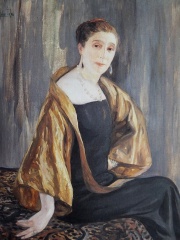
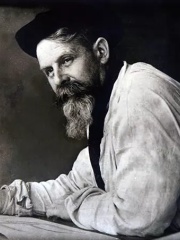
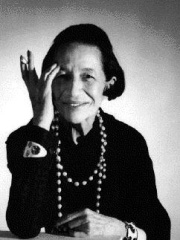
The Most Famous
DESIGNERS from France
This page contains a list of the greatest French Designers. The pantheon dataset contains 104 Designers, 11 of which were born in France. This makes France the birth place of the 4th most number of Designers behind United States, and Italy.
Top 10
The following people are considered by Pantheon to be the top 10 most legendary French Designers of all time. This list of famous French Designers is sorted by HPI (Historical Popularity Index), a metric that aggregates information on a biography's online popularity. Visit the rankings page to view the entire list of French Designers.

1. René Lalique (1860 - 1945)
With an HPI of 69.30, René Lalique is the most famous French Designer. His biography has been translated into 31 different languages on wikipedia.
René Jules Lalique (French pronunciation: [ʁəne ʒyl lalik]; 6 April 1860 – 1 May 1945) was a French jeweller, medallist, and glass designer known for his creations of glass art, perfume bottles, vases, jewellery, chandeliers, clocks, and automobile hood ornaments.

2. Philippe Starck (b. 1949)
With an HPI of 66.58, Philippe Starck is the 2nd most famous French Designer. His biography has been translated into 30 different languages.
Philippe Starck (French pronunciation: [filip staʁk]; born 18 January 1949) is a French industrial architect and designer known for his wide range of designs, including interior design, architecture, household objects, furniture, boats and other vehicles. His most popular pieces were made in the 1980s and the 1990s. He is considered one of the pioneers of democratic design, aiming to offer the best possible service while using the minimum of materials, in order to improve the life of the user.

3. Aristide Cavaillé-Coll (1811 - 1899)
With an HPI of 66.55, Aristide Cavaillé-Coll is the 3rd most famous French Designer. His biography has been translated into 24 different languages.
Aristide Cavaillé-Coll (French: [aʁistid kavaje kɔl]; 4 February 1811 – 13 October 1899) was a French organ builder. He has the reputation of being the most distinguished organ builder of the 19th century. He pioneered innovations in the art and science of organ building that permeated the profession and influenced the course of organ building, composing and improvising through the early 20th century. As the author of scientific journal articles about the organ construction details, he published the results of his research and experiments. He was the inventor of the symphonic organ being able to follow smooth and immediate dynamic changes like a symphonic orchestra. His most famous organs were built in Paris in Saint-Denis Basilica (1841), Église de la Madeleine, Sainte-Clotilde Basilica (1859), Saint-Sulpice church (his largest instrument; behind the classical façade), Notre-Dame Cathedral (behind the classical façade), baron Albert de L'Espée's residence in Biarritz (moved finally to the Sacré-Cœur Basilica), and many others. The organ reform movement in the 20th century sought to return organ building to a more Baroque style; but since then, Cavaillé-Coll's designs have come back into fashion.

4. Raymond Loewy (1893 - 1986)
With an HPI of 65.74, Raymond Loewy is the 4th most famous French Designer. His biography has been translated into 30 different languages.
Raymond Loewy ( LOH-ee, French: [ʁɛmɔ̃ levi]; November 5, 1893 – July 14, 1986) was a French-born American industrial designer who achieved fame for the magnitude of his design efforts across a variety of industries. He was recognized for this by Time magazine and featured on its cover on October 31, 1949. Loewy spent most of his professional career in the United States, becoming a naturalized citizen in 1938. Among his designs were the Shell, Exxon, TWA and the former BP logos, the Greyhound Scenicruiser bus interior, Coca-Cola vending machines and bottle redesign, the Lucky Strike package, Coldspot refrigerators, the Studebaker Avanti and Champion, and the Air Force One livery. He was engaged by equipment manufacturer International Harvester to overhaul its entire product line, and his team also assisted competitor Allis-Chalmers. He undertook numerous railroad designs, including the Pennsylvania Railroad GG1, S-1, and T1 locomotives, the color scheme and Eagle motif for the first streamliners of the Missouri Pacific Railroad, and a number of lesser known color scheme and car interior designs for other railroads. His career spanned seven decades. The press referred to Loewy as The Man Who Shaped America, The Father of Streamlining and The Father of Industrial Design.
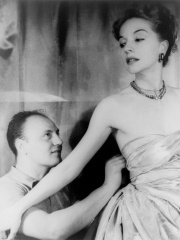
5. Pierre Balmain (1914 - 1982)
With an HPI of 65.69, Pierre Balmain is the 5th most famous French Designer. His biography has been translated into 28 different languages.
Pierre Alexandre Claudius Balmain (French pronunciation: [pjɛʁ balmɛ̃]; 18 May 1914 – 29 June 1982) was a French fashion designer and founder of leading post-war fashion house Balmain. Known for sophistication and elegance, he described the art of dressmaking as "the architecture of movement".

6. Claude Garamond (1499 - 1561)
With an HPI of 64.08, Claude Garamond is the 6th most famous French Designer. His biography has been translated into 27 different languages.
Claude Garamont (c. 1510–1561), known commonly as Claude Garamond, was a French type designer, publisher and punch-cutter based in Paris. Garamond worked as an engraver of punches, the masters used to stamp matrices, the moulds used to cast metal type. He worked in the tradition now called old-style serif design, which produced letters with a relatively organic structure resembling handwriting with a pen but with a slightly more structured and upright design. Considered one of the leading type designers of all time, he is recognised to this day for the elegance of his typefaces. Many old-style serif typefaces are collectively known as Garamond, named after the designer. Garamond was one of the first independent punchcutters, specialising in type design and punch-cutting as a service to others rather than working in house for a specific printer. His career therefore helped to define the future of commercial printing with typefounding as a distinct industry to printing books.

7. Jeanne Lanvin (1867 - 1946)
With an HPI of 63.73, Jeanne Lanvin is the 7th most famous French Designer. Her biography has been translated into 25 different languages.
Jeanne-Marie Lanvin (French: [ʒan maʁi lɑ̃vɛ̃]; 1 January 1867 – 6 July 1946) was a French haute couture fashion designer. She founded the Lanvin fashion house and the beauty and perfume company Lanvin Parfums.

8. Louis Majorelle (1859 - 1926)
With an HPI of 59.90, Louis Majorelle is the 8th most famous French Designer. His biography has been translated into 22 different languages.
Louis-Jean-Sylvestre Majorelle, usually known simply as Louis Majorelle, (26 September 1859 – 15 January 1926) was a French decorator and furniture designer who manufactured his own designs, in the French tradition of the ébéniste. He was one of the outstanding designers of furniture in the Art Nouveau style, and after 1901 formally served as one of the vice-presidents of the École de Nancy. Louis Majorelle is one of those who contributed the most to the transformation of furniture. Thanks to posterity, we recognize today a piece of furniture from him as we recognize a piece of furniture from André Charles Boulle and Charles Cressent, the French Prince regent's favorite artists. During the early 18th century, Cressent replaced the magnificence of ebony and tortoiseshell associated with tin and copper by the softer harmonies of foreign woods. Like him, Louis Majorelle dressed the elegant structure of Art Nouveau furniture with exotic wood inlays. The palette he composed with wood from France and abroad, resembles that of a painter. Oak, walnut, ash, elm, holly, plane, chestnut, cherry, pear and beech provide the soft tones and the enveloping range of grays; they serve Majorelle in calm and deliberately monochrome compositions. Rosewood provides the delicate colors and patterns of the flower. The tender yellow lemon tree, the silver maple, the purple amaranth, dear to Cressent, the jacaranda wood, the red satin, the amourette, the orange clairembourg, the black or green ebony, the red or black palm, etc., constituted for him, among the foreign essences, the most extensive colored swell, where his painter instincts could flourish.

9. Diana Vreeland (1903 - 1989)
With an HPI of 59.03, Diana Vreeland is the 9th most famous French Designer. Her biography has been translated into 19 different languages.
Diana Vreeland (September 29, 1903 – August 22, 1989) was an American fashion columnist and editor. She worked for the fashion magazine Harper's Bazaar and as editor-in-chief at Vogue, later becoming a special consultant to the Costume Institute of the Metropolitan Museum of Art. She was named on the International Best Dressed List Hall of Fame in 1964. Vreeland coined the term youthquake in 1965.

10. Nicolas Jenson (1420 - 1480)
With an HPI of 57.95, Nicolas Jenson is the 10th most famous French Designer. His biography has been translated into 18 different languages.
Nicholas (or Nicolas) Jenson (c. 1420–1480) was a French engraver, pioneer, printer and type designer who carried out most of his work in Venice, Italy. Jenson acted as Master of the French Royal Mint at Tours and is credited with being the creator of one of the finest early Roman typefaces. Nicholas Jenson has been something of an iconic figure among students of early printing since the nineteenth century when the artist William Morris praised the beauty and perfection of his roman font. Jenson is an important figure in the early history of printing and a pivotal force in the emergence of Venice as one of the first great centers of the printing press.
People
Pantheon has 11 people classified as French designers born between 1420 and 1949. Of these 11, 1 (9.09%) of them are still alive today. The most famous living French designers include Philippe Starck. The most famous deceased French designers include René Lalique, Aristide Cavaillé-Coll, and Raymond Loewy.
Living French Designers
Go to all RankingsDeceased French Designers
Go to all RankingsRené Lalique
1860 - 1945
HPI: 69.30
Aristide Cavaillé-Coll
1811 - 1899
HPI: 66.55
Raymond Loewy
1893 - 1986
HPI: 65.74
Pierre Balmain
1914 - 1982
HPI: 65.69
Claude Garamond
1499 - 1561
HPI: 64.08
Jeanne Lanvin
1867 - 1946
HPI: 63.73
Louis Majorelle
1859 - 1926
HPI: 59.90
Diana Vreeland
1903 - 1989
HPI: 59.03
Nicolas Jenson
1420 - 1480
HPI: 57.95
Jean Louis
1907 - 1997
HPI: 51.25
Overlapping Lives
Which Designers were alive at the same time? This visualization shows the lifespans of the 8 most globally memorable Designers since 1700.

